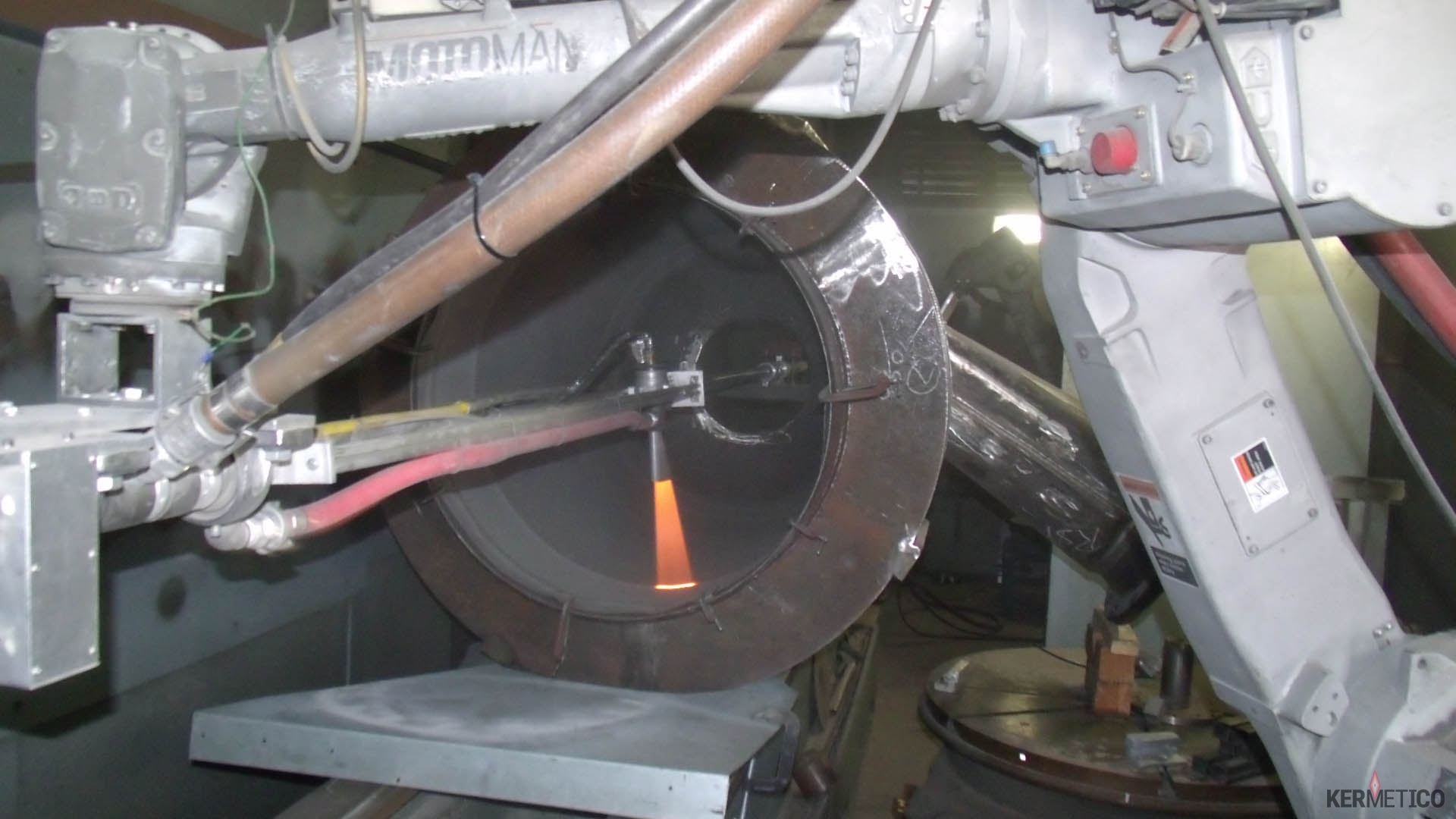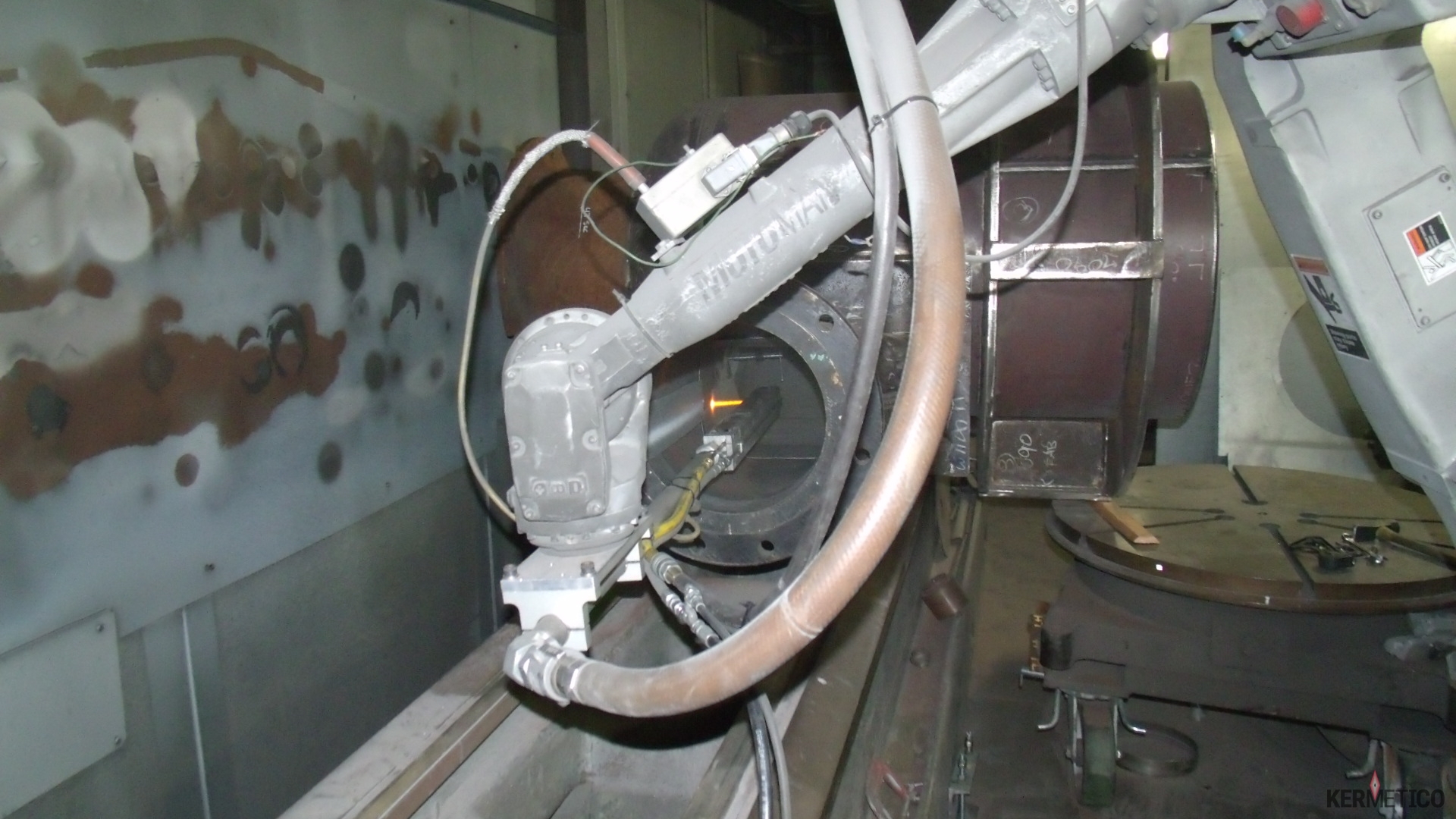Erosion in cyclones is caused by small particles striking the inside walls of a vortex separator and rubbing off material. Erosive wear increases with high dust loadings, high inlet velocities, high particle specific gravity values and the strike angle (Air Pollution Engineering Manual, 2000).
The area of the cyclone’s cylindrical shell opposite to the inlet may experience excessive wear if the gas contains large dust particles. Welded seams in the cyclone design are also subject to increased wear because of surface irregularities.
Using abrasion resistant separator coatings at the strike zone and over the welded areas could be an effective way to prevent erosive wear of the shells of separation equipment.
Surface Treatment to Protect Cyclone Walls from Wear
Tungsten carbide coatings deposited by using different high velocity thermal spray technologies (HVOF, HVAF, Detonation), are extremely wear-resistant. Industry uses tungsten carbide in combination with cobalt, nickel or cobalt-chrome matrices preferably. The erosion and corrosion behavior of thermal spray coatings is a major factor for the assessment of the coating application.
We use our Kermetico HVAF equipment to deposit tungsten carbide coatings that are wear-resistant and tough enough to be used at all angles of impingement. Even 100 microns (0.004”) of our WCCoCr coating is gas-tight, protecting a cyclone metal from wear and corrosive agents as a barrier lining.
We use tungsten carbide cobalt chromium powders because they exhibit the highest wear resistance coupled with good deposition efficiency.
Since 2006 we have been spraying separation equipment in-house and have been engineering HVAF spraying equipment for the application.
Our Kermetico HVAF equipment lets us spray superior coatings to protect cyclone walls from erosion.
A Comparison of Abrasive Wear and Erosion Protection Properties of HVOF and Kermetico HVAF Coatings
Variable angles of attack are typical for cyclones and separators.
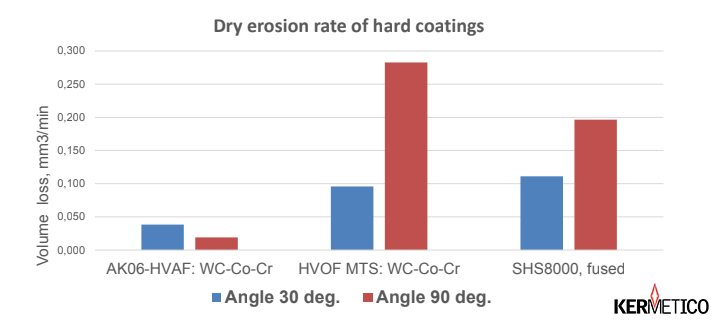
Michigan Thermal Spray Dry Erosion Test
This test has compared a Kermetico HVAF tungsten carbide coating to the same material coating deposited by industry-leading HVOF equipment and with a fused amorphous layer. Our HVAF tungsten carbide coating behaved as a hard and ductile material.
The two following charts are courtesy of the Central Power Research Institute of India.

Hardness HVOF vs HVAF Tungsten Carbide WCCoCr Coatings
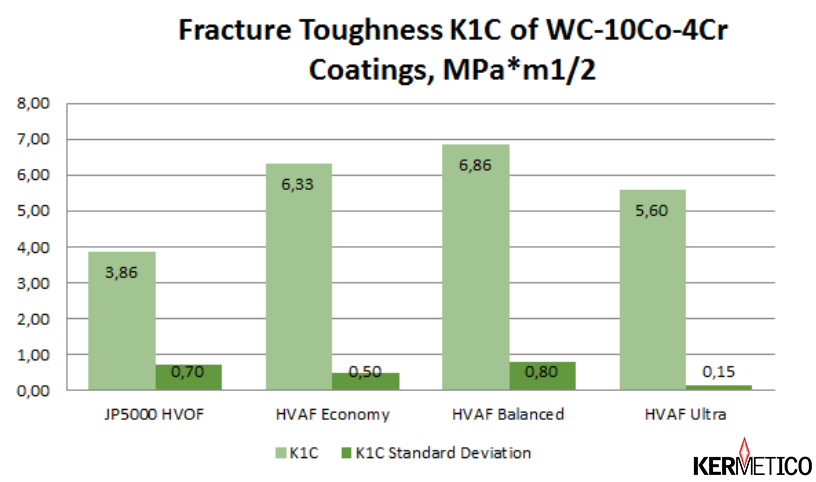
A Comparison of Toughness K1C of HVOF and Three Kermetico HVAF WCCoCr Coatings
Could the reason for this result be that we are comparing ourselves to less than the best available coating equipment?
You may also be interested in a comparison of Kermetico HVAF cemented carbide coatings with one of the most advanced HVOF systems on the market.
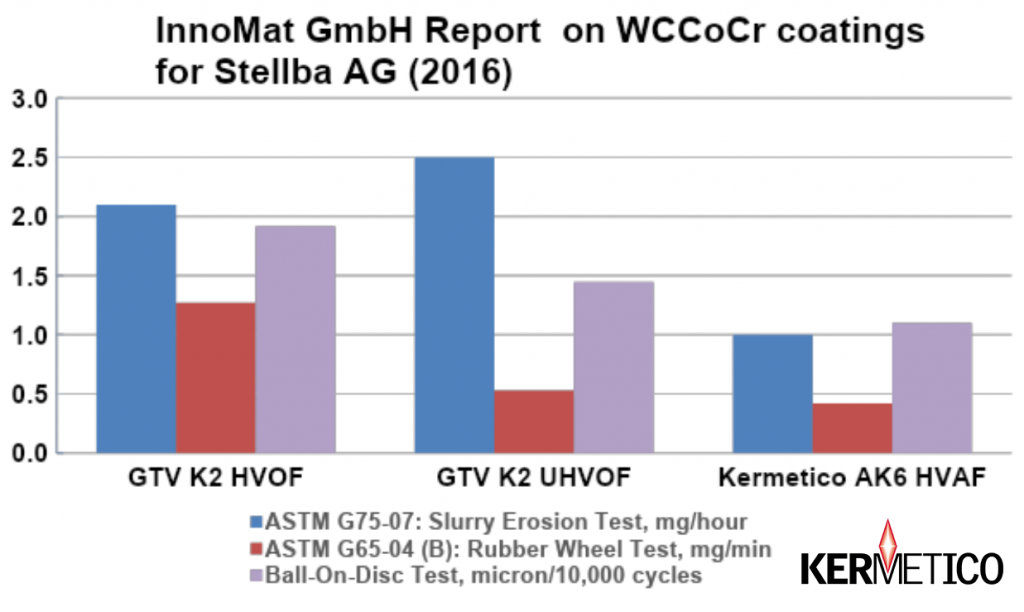
A Comparison of HVAF WCCoCr Coatings with HVOF and Ultra-HVOF Specimens
Are you interested in how our HVAF Balanced and Ultra modes provide such superior results?
The Scientific Research of HVAF and HVOF Abrasion Lining
As Prof. Wang has shown in his article “Wear and corrosion performance of WC-10Co4Cr coatings deposited by different HVOF and HVAF spraying processes”:
“Three WC-10Co4-Cr coatings were deposited by HVOF and HVAF processes, and their microstructure and properties were investigated in this study. The following conclusions were drawn as a result.
(1) The WC-10Co4Cr coating deposited by the HVAF spraying process exhibited nearly the same phase composition as its initial feedstock powder, which included mainly the WC and some Co3W3C and crystal Co phases with nearly no decarburisation. The JK coating sprayed with Jet Kote III-HVOF equipment exhibited the most severe decarburisation with high-intensity W2C and even metallic W phase. The phase composition of the JP coating deposited by the JP8000-HVOF system was composed of main WC and minor W2C peaks and exhibited a light degree of decarburisation.
(2) The wear resistance and mechanism of the HVOF/HVAF-sprayed coatings were influenced not only by their hardness but also by their fracture toughness. The high hardness of carbide coating could effectively hinder the cuts caused by the abrasives, and their high toughness could make the binder absorb some of the energy caused by abrasive attacks with some degree of plastic deformation.
(3) The WC-10Co4Cr coatings, which had different degrees of decarburisation, exhibited different dominant wear mechanisms.
(4) The electrochemical corrosion resistances and mechanisms of HVAF- and HVOF-sprayed WC-10Co4Cr coatings were influenced by their phase compositions and microstructures.”
Scientists tell us that our HVAF technology provides better wear and erosion resistance than any HVOF process.
And practice supports it, showing longer lifecycles for HVAF tungsten carbide coatings.
Our HVAF process is also less expensive than HVOF.
Economic Aspects of Kermetico HVAF Separator Coatings
The list price of equipment is lower than the price of a good HVOF equipment.
A Comparison of our HVAF and HVOF cost per kilogram of deposited WC-10Co-4Cr (prices in Texas, USA).
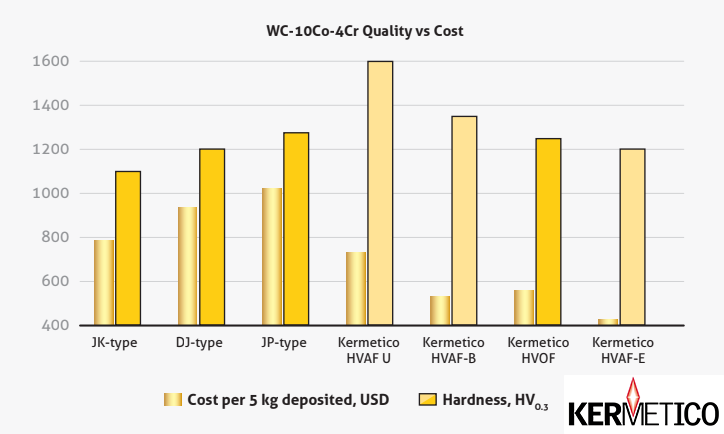
HVOF vs HVAF Tungsten Carbide Coating Quality-Cost Analysis
With Kermetico HVOF and HVAF thermal spray systems, we are not limited to the “best coating possible” anymore.
We can choose how to spray a tungsten carbide coating:
- save money spraying in HVAF economy mode, getting HVOF quality with lower costs
- deposit the highest quality coating in HVAF Ultra mode to achieve a coating with high hardness, ductility, impermeability with excellent abrasion and cavitation resistance
- or choose HVAF Balanced mode to gain a competitive edge in both cost and quality
But the story doesn’t end here.
Blast and Spray Cyclone Coatings with Kermetico High Velocity Equipment
We recommend depositing cyclone coatings using robotic blast and spray operations.
We blast a surface with a Kermetico HVAF gun (it is extremely fast and uniform) and spray with the same gun after switching the powder feed hose and perhaps changing the nozzle
It is much faster, more accurate and consumes much less grit than manual blasting.
It also provides very even surface preparation and induces less stress into the base metal.
Kermetico HVAF and HVOF Thermal Spray Coating Equipment
Kermetico designs and manufactures the following HVAF and HVOF thermal spray equipment to protect separation equipment from abrasive wear, corrosion and erosion:
- Convertible HVOF and HVAF equipment:
- Multifunctional HVAF AK systems, with a selection of spray guns:
- AK7 – a high-power gun for the thermal spray of large parts – recommended for cyclone separator coatings
- AK6 – a gun to deposit tungsten and chromium carbides with spray rates up to 466 g/min (63 lbs./hour)
- AK5 – a compact spray gun to efficiently deposit coatings onto smaller parts and complex geometries. Maximum spray rate – 250 g/min. (33 lbs./hour)
- AK-ID – a gun to spray internal diameters 88 mm (3.47”) and larger. Maximum spray rate – 83 g/min. (11 lbs./hour) – recommended for separator nozzles
- AK-HH – a hand-held HVAF gun to spray manually on-site or on complex surfaces – maximum spray rate – 250 g/min. (33 lbs./hour)
- Additional equipment:
- An HVAF grit feeder for HVAF part blasting to reduce coating costs
- A Gas Permeability Tester for an instant check of coating through porosity
Kermetico, Inc. – HVAF and HVOF Material Science Excellence, Equipment Manufacturing and Thermal Spray Coating Services Since 2006
We create our equipment to help material scientists, engineers and business managers achieve their goals.
We have installed more than 60 Kermetico HVAF and HVOF systems in the USA, Europe, Japan, and China.
Some of the systems are at work in Universities and National Labs, but most of them work in production thermal spray shops.
We proudly design and produce our thermal spray equipment in California and install it all over the world.
You can visit our R&D center in Benicia to meet our designers and see our HVAF and HVOF equipment in action.
We also provide HVAF and HVOF thermal spray coating services to customers in North America.

